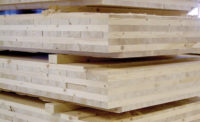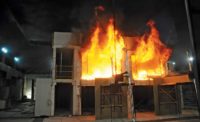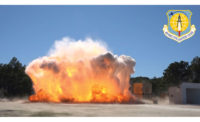Based on recent fire test results, mass timber groups have adjusted product certification standards to require the use of cross-laminated timber with structural adhesives tested to demonstrate better fire performance.
Though the new CLT standards are not going to be published and adopted by jurisdictions until 2021 or later, wood interests are “actively” working with adhesive suppliers and CLT manufacturers to implement the new requirements in the next few months, according to Borjen Yeh, technical services director for APA-The Engineered Wood Association.
One of several CLT product certifiers, APA also is the developer of the expanded national consensus standard, ANSI/APA PRG 320-2018, Standard for Performance-Rated Cross-Laminated Timber.
The International Code Council’s ad hoc committee on tall wood buildings (TWB), which is proposing CLT provisions for the ICC’s 2021 model International Building Code and International Residential Code, is updating its proposals to reflect the updated standard, which includes fire test requirements for CLT products. “I believe this new test standard, being so much more robust, will help assure interested parties that the CLT will exhibit a more predictable fire performance,” says Stephen J. DiGiovanni, a fire department protection engineer with Clark County, Nev., and TWB committee chairman.
CLT is a large-scale, prefabricated, solid engineered wood panel, consisting of several layers of kiln-dried lumber boards stacked in alternating directions, bonded with structural adhesives. The new product certification standard focuses on adhesives with a higher level of thermal performance.
One of six recent fire tests, designed by the National Research Council Canada (NRC) and conducted at the National Institute of Standards and Technology, inspired the PRG 320 update. The test of a furnished, 9.1-meter by 4.6-m CLT compartment with an exposed CLT ceiling, 2.7 m high, showed the potential for regrowth of a fire within the compartment, nearly 2 hours and 40 minutes after ignition.
Analysis of the CLT revealed that the fire regrowth was the result of a glue line failure due to elevated temperatures near the slowly advancing char front, which resulted in a delamination that exposed uncharred wood that reignited, according to researchers led by Joseph Su, NRC’s principal research officer for fire safety. The tests, initiated by the National Fire Protection Association’s Fire Protection Research Foundation, were funded by $250,000 from the American Wood Council (AWC) and $175,000 from NFPA’s Property Insurance Research Group.
After the delamination and fire regrowth, TWB requested evidence that CLT can be manufactured with adhesives that cause the product to act like solid wood—which continuously chars to insulate the rest of the member—with no char drop-off caused by adhesive failure, according to AWC.
Subsequently, CLT manufactured with a range of existing and improved adhesives was tested and demonstrated the satisfactory, non-fire-regrowth performance sought by TWB for use in tall mass timber buildings, AWC adds.
A compartment fire test protocol and an additional small-scale delamination fire test are now mandatory in the recently approved PRG 320-2018.
DiGiovanni is satisfied that the updated PRG 320 addresses the issue of delamination more accurately.
The NRC fire tests were “extreme tests,” assuming sprinkler protection had failed and the fire department did not carry out any suppression activities, says David Barber, a principal of Arup Fire and a member of the NRC test advisory panel. “Very few construction products are tested to these fire extremes.”







Post a comment to this article
Report Abusive Comment